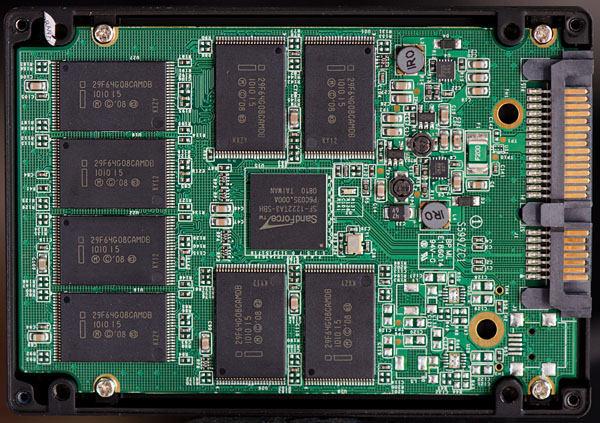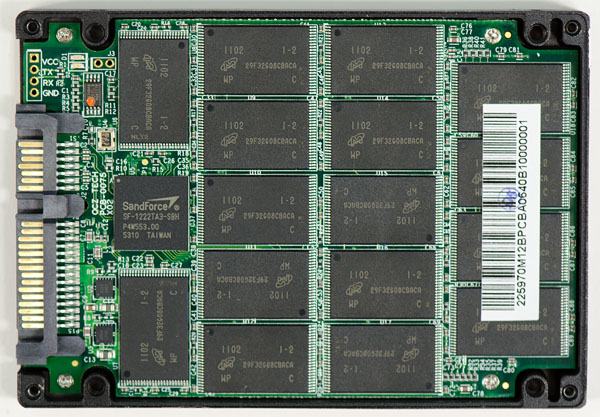The OCZ Vertex 3 Review (120GB)
by Anand Lal Shimpi on April 6, 2011 6:32 PM ESTThe Real Issue
While I was covering MWC a real issue with OCZ's SSDs erupted back home: OCZ aggressively moved to high density 25nm IMFT NAND and as a result was shipping product under the Vertex 2 name that was significantly slower than it used to be. Storage Review did a great job jumping on the issue right away.
Let's look at what caused the issue first.
When IMFT announced the move to 25nm it mentioned a doubling in NAND capacity per die. At 25nm you could now fit 64Gbit of MLC NAND (8GB) on a single die, twice what you could get at 34nm. With twice the density in the same die area, costs could come down considerably.

An IMFT 25nm 64Gbit (8GB) MLC NAND die
Remember NAND manufacturing is no different than microprocessor manufacturing. Cost savings aren't realized on day one because yields are usually higher on the older process. Newer wafers are usually more expensive as well. So although you get ~2x density improvement going to 25nm, your yields are lower and wafers are more expensive than they were at 34nm. Even Intel was only able to get a maximum of $110 decrease in price when going from the X25-M G2 to the SSD 320.
OCZ was eager to shift to 25nm. Last year SandForce was the first company to demonstrate 25nm Intel NAND on an SSD at IDF, clearly the controller support was there. As soon as it had the opportunity to, OCZ began migrating the Vertex 2 to 25nm NAND.
SSDs are a lot like GPUs, they are very wide, parallel beasts. While a GPU has a huge array of parallel cores, SSDs are made up of arrays of NAND die working in parallel. Most controllers have 8 channels they can use to talk to NAND devices in parallel, but each channel can often have multiple NAND die active at once.

A Corsair Force F120 using 34nm IMFT NAND
Double the NAND density per die and you can guess what happened next - performance went down considerably at certain capacity points. The most impacted were the smaller capacity drives, e.g. the 60GB Vertex 2. Remember the SF-1200 is only an 8-channel controller so it only needs eight devices to technically be fully populated. However within a single NAND device, multiple die can be active concurrently and in the first 25nm 60GB Vertex 2s there was only one die per NAND package. The end result was significantly reduced performance in some cases, however OCZ failed to change the speed ratings on the drives themselves.
The matter is complicated by the way SandForce's NAND redundancy works. The SF-1000 series controllers have a feature called RAISE that allows your drive to keep working even if a single NAND die fails. The controller accomplishes this redundancy by writing parity data across all NAND devices in the SSD. Should one die fail, the lost data is reconstructed from the remaining data + parity and mapped to a new location in NAND. As a result, total drive capacity is reduced by the size of a single NAND die. With twice the density per NAND die in these early 25nm drives, usable capacity was also reduced when OCZ made the switch with Vertex 2.
The end result was that you could buy a 60GB Vertex 2 with lower performance and less available space without even knowing it.

A 120GB Vertex 2 using 25nm Micron NAND
After a dose of public retribution OCZ agreed to allow end users to swap 25nm Vertex 2s for 34nm drives, they would simply have to pay the difference in cost. OCZ realized that was yet another mistake and eventually allowed the swap for free (thankfully no one was ever charged), which is what should have been done from the start. OCZ went one step further and stopped using 64Gbit NAND in the 60GB Vertex 2, although drives still exist in the channel since no recall was issued.
OCZ ultimately took care of those users who were left with a drive that was slower (and had less capacity) than they thought they were getting. But the problem was far from over.










153 Comments
View All Comments
sor - Thursday, April 7, 2011 - link
Oh sure, I agree that the bottom line is whether or not it still works, that's why they do the binning and have grades of product within that brand. If OCZ can use cheaper flash and the controller takes care of the increased failures, or the users never reach the failure threshold, then who cares, as long as the product works the same?I can't speak for the testing procedures within SpekTek or their tolerances, as I only worked for a facility that tested parts for Micron, and in the process generated the bad parts and did some of the binning before sending them to SpekTek. Much of the stuff that went to them failed our tests but was otherwise not physically damaged.
There's a reason why those parts are sold under the SpecTek brand at a discount, it shows that even the manufacturer doesn't trust them to be sold under the good brand after testing.
Panlion - Thursday, April 7, 2011 - link
I wonder if OCZ will produce a 7mm 2.5 inch drive. The newer notebooks from Lenovo are starting to demand that format it'll be nice if I can have some option other than Intel SSD.sleepeeg3 - Thursday, April 7, 2011 - link
Maintaining integrity while sticking out for the little guy, instead of bending over backward to write glowing articles for every vendor sponsor. That's what has made this site succeed.I wish you could also take OCZ to task on SandForce's controller strange tendency to lock up and vanish from a system, due to built in encryption. They are in complete denial that it is an issue, despite dozens of reports on their user forums.
edfcmc - Thursday, April 7, 2011 - link
Thank you Anand for this very informative and in-depth review of the OCZ issue and their latest 120gb vertex 3 product; especially since the 120gb products are within my price range and the size I am looking to purchase. On a side note, I have been reading your reviews since your review of the FIC PA-2007 many years ago and I love the evolution of this site and your dedication to keeping us consumers informed.p.s. Please consider asking asus/Nvidia to update the Nvidia driver on their ULV80 series as nothing new has been updated since I purchased the UL80vt based on this site's recommendation. Asus/Nvida seem to be a little non-responsive to us folks who have been requesting an update for quite some time.
ekerazha - Thursday, April 7, 2011 - link
Can't wait for reviews of SSDs (Intel G3, Crucial m4) with comparable size (120 GB).Chloiber - Thursday, April 7, 2011 - link
Anand:Just a quick note. In the newest SF-firmware, there is also still a bug with Hynid Flash. You can see it here, under "Open Issues":
http://www.ocztechnologyforum.de/forum/showthread....
"Under benchmarking scenarios with IOMETER 2006, 60GB drives that use Hynix32nm MLC (1024 blocks, 8KB pages) can impose long latencies"
Just FYI.
MarcHFR - Thursday, April 7, 2011 - link
Dear OCZ, Dear Anand,In the past, it was simple :
Vertex : always the same NAND
Agility : NAND could change
I know that Vertex name is a best seller for OCZ, but i think it will be simplier to back to this
strikeback03 - Friday, April 8, 2011 - link
That is what I was wondering, I thought the point of the Agility line was that they would use the good controller but possibly cheaper NAND.Adul - Thursday, April 7, 2011 - link
Why not make use of QOR codes so a shopper can just scan the code to be taken to a page with more detail information.miscellaneous - Thursday, April 7, 2011 - link
Given this particularly insidious paragraph:"OCZ will also continue to sell the regular Vertex 2. This will be the same sort of grab-bag drive that you get today. There's no guarantee of the NAND inside the drive, just that OCZ will always optimize for cost in this line."
Will these "grab-bag" drives be using the same SKU(s)/branding as the original - well reviewed - Vertex 2? If so, how is using the _old_ SKU(s) to identify the _new_ "grab-bag" drives, whilst introducing _new_ SKU(s) to help identify drives with the _old_ level of performance a satisfactory solution?